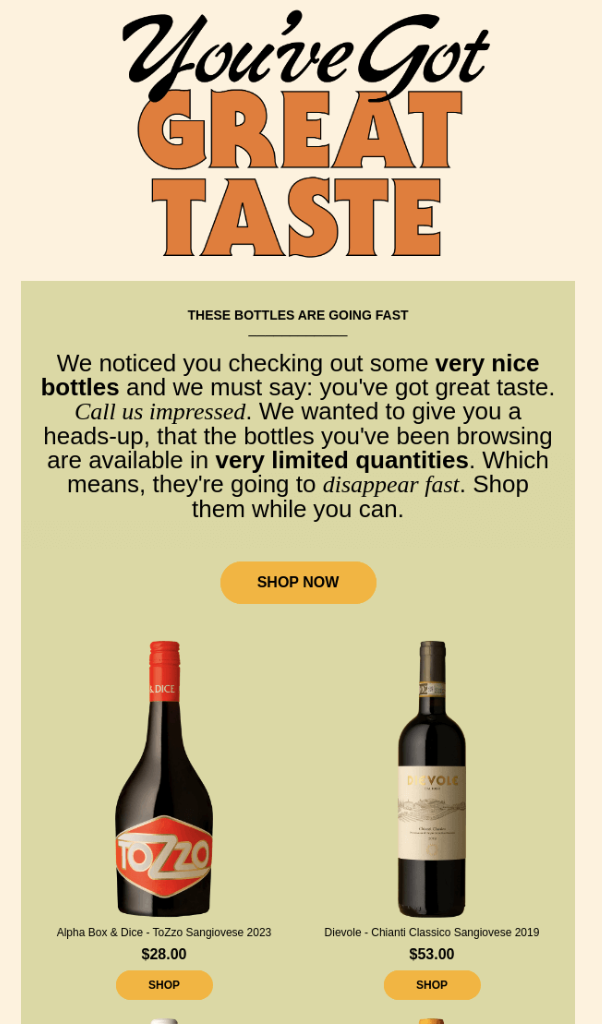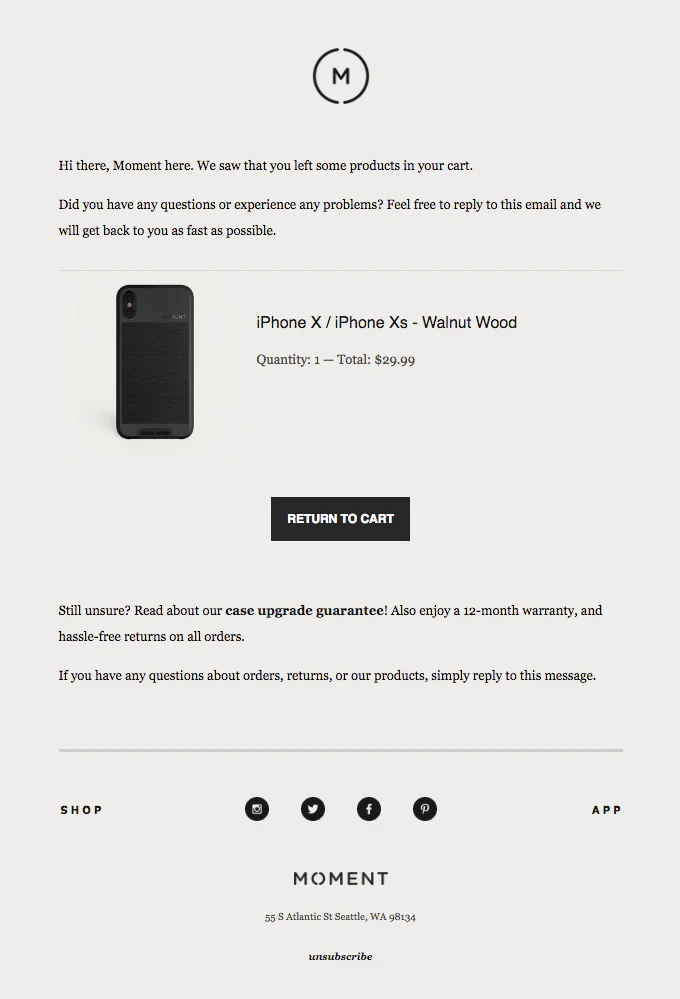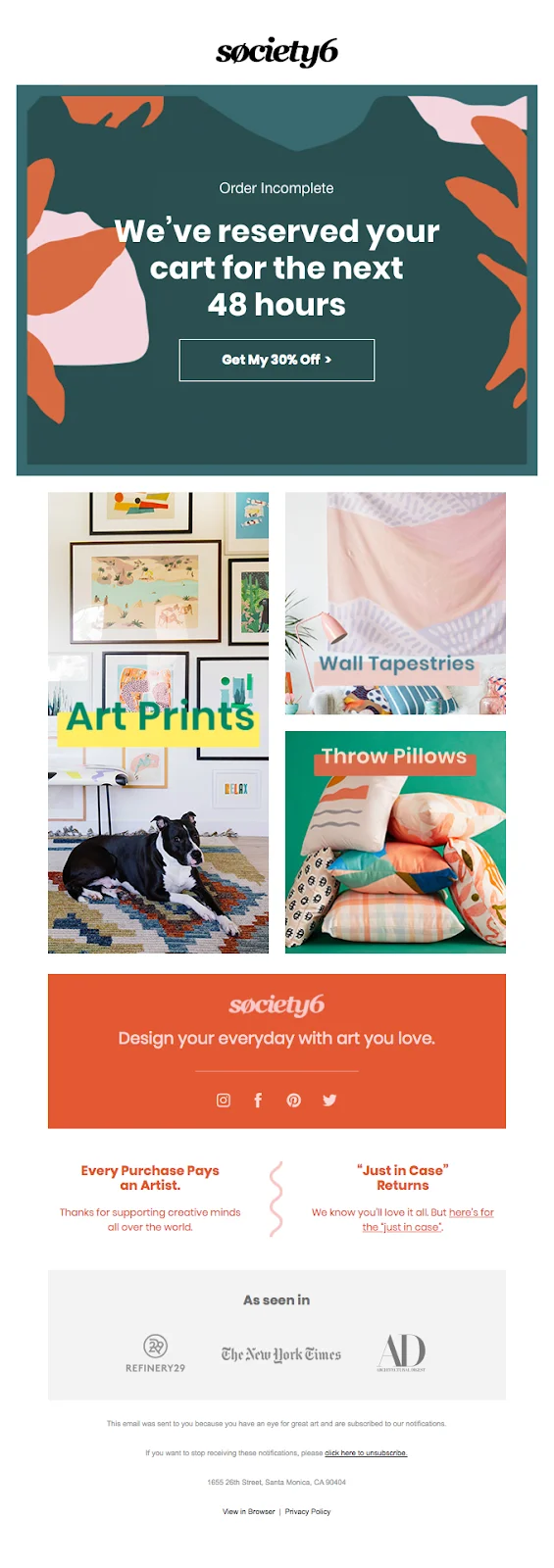When to Send an Abandoned Cart Series: Email & SMS

The longer you wait after cart abandonment, the harder it is for your brand to bring the shopper back and recover the cart. Most purchases happen within hours of the cart event, while intent is still high and the product is still top of mind.
That’s why your abandoned cart emails should be sent at the right time (not too early nor too late) to convert the shopper.
But, how do you know when to send abandoned cart series and time the different reminders within your flow to drive more clicks and conversions?
This guide gives you real test data to plan your abandoned cart emails, exact timing benchmarks, and strategies for multi-channel layering (like with SMS and push notifications) as well as segment-specific flows.
Why send time matters for abandoned cart emails
Cart abandonment rate is around 70-80%, and most of those unrecovered carts aren’t due to bad email copy or weak discounts. They happen because the timing is off:
- Send too early, and you come across as desperate, interrupting before the buyer is ready.
- Send too late, and they’ve either forgotten about the product or purchased from a competitor.
Timing is the most impactful variable to optimize once your cart series fundamentals are in place. For example, Monday often sees the highest open rates at 51.90%, while Friday follows closely behind.
Whether you're emailing or texting, your goal is to hit the online shopper’s next high-engagement window. According to research, this typically means late morning or early evening in their local timezone.
Your cart reminder’s timing isn’t just influenced by shopper behaviour but also by product pricing. For low-AOV or fast-moving products, the first abandoned cart email or SMS might need to hit within 15–30 minutes. For higher-consideration purchases (think $200+), a 2-4 hour delay may work better.
“Shorter is better for the first send. For low-AOV products, we’ve triggered in as little as 15 minutes. For higher-ticket items, it could be a few hours. But always test—it depends on the product and purchase behavior.”
- Marina Carroll, Head of CRM Strategy at New Standard Co.
Essentially, there’s no right or wrong rule to send emails. Brands with the best-performing flows test their delay windows against their actual time-to-purchase data.
Optimal baseline cadence
Most brands default to a 1-hour, 24-hour, 72-hour cart abandonment sequence. But recent A/B tests across DTC brands show there’s a sharper baseline cadence that performs better across key metrics, especially revenue per recipient (RPR) and conversion rate per flow send.
Here’s the cadence that’s outperforming the traditional email timing strategy:
First touchpoint: 45 to 90 minutes post-abandonment
Shoppers have left the site but are still mentally in “shopping mode.” This is why you need to get that first reminder out sooner rather than later. Waiting at least 45 minutes makes sure that you’re not messaging them while they’re still on your site (or refreshing their cart). But beyond 90 minutes, you risk missing that decision window altogether.
“In general, regardless of product types or AOV, it's better to send the first email sooner rather than later. I recommend aiming for a window of 30 minutes to a couple of hours for the first send.”
- Marina Carroll
The key here is to avoid:
- Anything under 30 minutes, as this might feel clingy.
- Delays over 2 hours, which might lead to conversion rates dropping off.
Second touchpoint: 18 to 22 hours later
An 18-22 hour window aligns with the shopper’s next active inbox session, usually mid-morning the following day. This outperforms the blunt “24-hour rule” by up to a 25% conversion lift in controlled tests.
Here are some best practices to follow when setting up the second reminder:
- Use this touchpoint for education, social proof, testimonials, or addressing common objections.
- Display relevant product recommendations to spark curiosity and bring them back to your ecommerce store.

Looking for ways to improve the subject line of your abandoned cart emails and increase opens? Read our article on the 15 subject line tactics you can use.
Third touchpoint: Day 3 or 4 (avoid weekends)
By sending the third (and last) email 72-96 hours post-abandonment, you can avoid weekend lulls when open and click rates often tank.
"I would personally not introduce a discount until email three. You have a good chunk of people that are just converting off of that email number one and two reminder."
- Marina Carroll
Many online retailers use the third email to create FOMO (Fear of Missing Out) or offer incentives for shoppers who’ve resisted the first two reminders.
Best practices to follow across your email series
- While you should plan send times based on prior engagement data, many reports claim that the best-performing send windows are Tuesday through Thursday, and early morning or late afternoon.
- Avoid going beyond 3 touches unless you’re in luxury, high-AOV, or considered-purchase categories. In that case, extend to 5 to 7 days with content-driven nudges (no discounts).
- You can test adding a fourth email reminder to your sequence. When testing, track placed order rate (POR), which measures the number of customers who complete a purchase divided by the total recipients. For example, if your fourth email shows a high POR, it’s worth keeping. As Marina Carroll says,
“I always check the placed order rate. If it’s anywhere around 0.2, 0.3, 0.4, I’d say it’s probably not driving enough revenue.”
- Auto-suppress the flow once a purchase is completed. Continuing to send abandoned cart emails after a conversion directly impacts RPR and increases the risk of unsubscribes and spam complaints.
If you’re using Tie for identity resolution and engagement history, you can layer customer data into your flow logic. This lets you dynamically adjust timing and sequence length based on user behaviour and past purchase patterns, without manual rule-building.
Let’s say a repeat customer with a 30-day purchase cycle abandons their cart. With Tie, you can automatically shorten their cart recovery email sequence to 2 emails within 24 hours and avoid unnecessary email sends. This leads to higher engagement and lower email fatigue, improving both RPR and list health.
Non-obvious segment-based timing tweaks
Once your abandoned cart flow is performing at baseline, the next step is to refine your timing logic based on shopper behavior and identity signals. By using the data you already have (demographics, session behavior, and purchase history), you can time each message to when that specific segment is most likely to convert.
Note: When setting up segments for abandoned cart flows, make sure that your segments are large enough. Optimizing for small segments doesn’t have a huge impact on conversion rates.
Here are 4 ways that ecommerce businesses running high-volume cart flows are making tactical adjustments to improve visibility and conversions:
Compress the first email for high-AOV, high-intent visitors
Shoppers who have a high average order value (AOV) and have shown high intent signals (like browsing your site multiple times in one day) are already close to making a decision. A small nudge is all you need to get them to complete the checkout process. Here are some best practices to tailor your abandoned cart email strategy:
- Trigger your first cart email at 30 minutes post-abandonment.
- Skip discounts entirely for this cohort.
- Focus on reinforcing product value, highlighting key benefits, or addressing purchase blockers like shipping costs, delivery time, and return policies.

Hold overnight mobile abandonments until morning
For shoppers who abandon carts on mobile devices after 10 PM local time, avoid sending an immediate follow-up email. Instead, delay your first cart email until 9 AM local time, when inbox engagement rates climb.
Late-night mobile users are typically in passive browsing mode. Reminders sent overnight see lower engagement and poor inbox placement the next morning. By shifting send time to their next active window, you can improve visibility and click-through rates.
Tie’s real-time device and timezone enrichment make it easy to trigger a morning-only window for late-night mobile abandoners, without manual list pulls or complex filters.
Collapse the series for short-cycle repeat buyers
For repeat customers with an average repurchase cycle under 30 days, a long cart email series with multi-day delays can create unnecessary friction. Instead, condense your workflow to 2 emails and send them within the first 24 hours:
- Email 1: Simple reminder to restock.
- Email 2: Scarcity trigger (e.g., low stock, limited availability).
These customers already trust the brand and typically convert quickly. Prolonged sequences just increase opt-out risk. Since your customer data includes purchase history and frequency, you can easily set up this segment of short-cycle repeater buyers without manual effort.

Suppress cart emails for unresolved anonymous shoppers
Many ecommerce brands face online shopping cart abandonment from anonymous visitors, but the ones that can successfully retrieve lost sales are those that leverage identity resolution. Tools like Tie help online stores to uncover anonymous sessions by accurately matching them to real customer profiles from consented third-party sources.
Not all anonymous visitors will be identified, though. Here’s the marketing campaign strategy we recommend to retarget anonymous carts.
- Wait up to 2 hours post-abandonment for identity resolution to run.
- If the tool identifies the user, trigger the full email marketing flow as usual.
- If they are still anonymous after 2 hours, shift the user into retargeting ads (Meta, Google, etc.).
Multichannel timing layer for better coverage
If you’re still treating abandoned cart recovery as an email-only flow, you’re missing opportunities to improve both reach and revenue per abandoner. Leading retention teams are layering SMS, push, and retargeting ads into their timing strategy, not as add-ons, but as deliberate replacements or complements to certain email touches.
“The major revenue-driving levers are: email, SMS, push, and onsite capture or optimization.”
- Marina Carroll

Here’s how to structure multichannel timing for cart recovery:
Replace the first email with SMS or push for high opt-in segments
For customers who have opted into SMS or push notifications and engage with them often, skip sending the first email and start with SMS or push instead.
SMS and push notifications have higher visibility within the first hour post-abandonment, making them ideal as the critical first touchpoint. This is especially effective among mobile-first audiences or for time-sensitive offers.
Here’s an example of this flow:
- Hour 1: SMS or push notification.
- Next day: The second email in your standard flow picks up where SMS left off.
Combine emails and retargeting ads for higher revenue per abandoner
Pushing a 1-hour delay email as the first reminder with same-day dynamic ads (Meta, Google) on day 1 and a follow-up email 3 days after abandonment consistently outperforms traditional cart flows.
“Every sale campaign uses all three channels, but we time them separately. You want to hit them at different points of the day, make them different touchpoints, so at the end of the day, they see it 7 times to finally get that purchase.”
- Marina Carroll
Here’s an example:
- Day 1:
- Hour 1: Email reminder.
- All day: Display dynamic shopping cart abandonment ads across paid channels.
- Day 3: Send final email (could include urgency or incentive).

Brands implementing this email + ad + email sequence are seeing 10% more revenue from abandoners compared to email-only control groups. This is because a multi-layered email flow increases total brand touchpoints across channels during the buyer’s decision window, without overwhelming them via any single channel.
Abandoned cart FAQs
How does Tie data improve cart-series timing?
Timing is only valuable if your emails reach the inbox and if you’re reaching cart abandoners in the first place. Here’s how Tie fixes both problems:
- Identity resolution: Tie turns 2 to 3x more guest checkouts into known users. That means more effective abandoned cart emails can be sent, not just to logged-in users.
- Behavioral data: Tie enriches user profiles with send-time data like timezone and browsing patterns (e.g., night owl vs. 9-to-5 shopper). This improves send-time optimization in tools like Klaviyo and Mailchimp.
- Deliverability protection: Tie’s deliverability features (engagement simulation and inbox monitoring) boost inbox placement. This is important because timing means nothing if your automated emails land in spam.
Brands like Beekman 1802 were losing revenue to unidentified abandoned cart shoppers. By integrating Tie, they identified over 32K shoppers and saw a 70% lift in recovered revenue within just 4 months.
How many abandoned cart emails should I send?
Send 2 to 3 abandoned cart emails to maximize visibility and drive conversions without affecting email deliverability. Some best practices for this are:
- Stop at the third email to avoid spam risk.
- Each email should add value. Don’t just repeat the same nudge.
- Spread the abandoned cart email sequence across 3-5 days for best performance.
For high-ticket abandoned items (over $200), you can send a 4th message:
- Position it as a “concierge” email or SMS.
- Include customer support, financing options, or a personalized email recommendation.
- A/B test this flow on a smaller segment before rolling it out widely.
What is the best time of day to send abandoned cart emails?
The best time of day to send abandoned cart emails is during each potential customer’s next high-engagement window:
- Late mornings (10-11 AM) and early evenings (5-7 PM) usually perform best.
- Overnight carts should be delayed until 8–11 AM local time the next day.
Tie adds timezone and open-history data to customer profiles, allowing platforms like Klaviyo to send emails when users are most likely to engage, maximizing CTRs and conversions.
Can I recover carts without an email address?
Yes, you can recover carts without an email address in 3 ways:
- Retargeting ads (Meta, Google)
- SMS (if the phone number is captured)
- Push notifications (if the visitor has opted in)
You can also identify these anonymous carts and capture customer details by using an identity resolution platform such as Tie. Here’s how it works:
- Tie identifies anonymous site visitors based on behavioral, device, and historical signals.
- Once matched, you can send cart abandonment flows, even without a login or form fill.
Does offering a discount in the first email hurt margins?
Yes, offering a discount in the first cart email can hurt your margins and impact long-term purchase behavior. Here’s why:
- It sets the wrong expectation: Shoppers learn to abandon carts and wait for a coupon, especially if they see the discount right away.
- It cannibalizes full-price sales: Many would have converted without a discount if nudged with social proof, a sense of urgency, or product reminders.
- It eats into margin upfront: On low AOV or high-volume abandoned products, even a small percentage off compounds quickly.
To avoid this, hold off on discounts until the third touchpoint. Use the first two emails to highlight product benefits, urgency (e.g., low stock), or social proof.
Additionally, reserve the discount for the final email to convert only price-sensitive shoppers. This way, you recover revenue without immediately cutting into margin.
What metrics matter post-iOS Mail Privacy?
The metrics that matter most after iOS Mail Privacy updates are revenue per recipient, click-to-purchase rate, and flow-level revenue per subscriber:
- Revenue per recipient (RPR) measures the total revenue generated by each email recipient. It's the most accurate metric for assessing how well your email campaigns are driving actual purchases.
- Click-to-purchase rate tracks the percentage of users who clicked on a link within your email and then made a purchase. Unlike simple click-through rates, CPR measures how many clicks are actually converting into sales.
- Flow-level revenue per subscriber (RPS) measures the total revenue generated by subscribers across the entire flow. This metric can be used to track performance across all your marketing automations.
Tie improves post-iOS tracking by suppressing fake opens and bot clicks. It also gives you a clean, accurate denominator for your revenue and click metrics.
Will SMS abandoned cart messages hurt email deliverability?
Sending SMS for abandoned carts will not affect email deliverability if managed properly. Here are some best practices to follow:
- Avoid sending SMS and the first email within the same hour. This can trigger spam filters or frustrate users.
- A smarter setup:
- Send the first SMS an hour after abandonment.
- Skip the first email for shoppers who’ve opted into SMS.
- For these shoppers, begin the email flow with the second email, sent the following day.
This way, you maintain timing, increase your reach and engagement across channels, and avoid hurting domain reputation.
How does Tie make timing smarter?
Tie makes abandoned cart email timing smarter by:
- Identifying more users: Reach more abandoners, including those who check out as guests or never submit a form.
- Feeding customer insights: Send behavioural and demographic attributes about customers to ESPs like Klaviyo.
- Improving inbox placement: Make sure your emails land in the inbox, not spam or promotions, by optimizing timing based on user behavior and engagement signals.
This is central to cart abandonment email best practices because timing means nothing if it doesn’t hit the inbox or target the right user.
Ready to improve your cart recovery strategy? Book a demo to see how Tie’s features help enhance timing, boost inbox visibility, and drive higher conversions.






